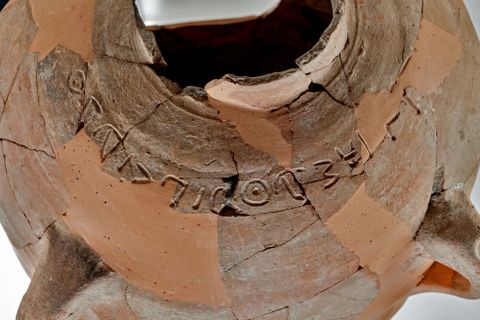Ish-bosheth Saul's son was forty years old when he began to reign over Israel, and reigned two years. But the house of Judah followed David. II Samuel 2:10
And the sons of Rimmon the Beerothite, Rechab and Baanah, went, and came about the heat of the day to the house of Ishbosheth, who lay on a bed at noon.
And they came thither into the midst of the house, as though they would have fetched wheat; and they smote him under the fifth rib: and Rechab and Baanah his brother escaped.
For when they came into the house, he lay on his bed in his bedchamber, and they smote him, and slew him, and beheaded him, and took his head, and gat them away through the plain all night.
And they brought the head of Ishbosheth unto David to Hebron, and said to the king, Behold the head of Ishbosheth the son of Saul thine enemy, which sought thy life; and the Lord hath avenged my lord the king this day of Saul, and of his seed.
And David answered Rechab and Baanah his brother, the sons of Rimmon the Beerothite, and said unto them, As the Lord liveth, who hath redeemed my soul out of all adversity,
When one told me, saying, Behold, Saul is dead, thinking to have brought good tidings, I took hold of him, and slew him in Ziklag, who thought that I would have given him a reward for his tidings:
How much more, when wicked men have slain a righteous person in his own house upon his bed? shall I not therefore now require his blood of your hand, and take you away from the earth?
And David commanded his young men, and they slew them, and cut off their hands and their feet, and hanged them up over the pool in Hebron. But they took the head of Ishbosheth, and buried it in the sepulchre of Abner in Hebron. II Samuel 4:5-12
Photograph credit: Tal Rogovsky
Eshbaal is referred to as Ish-bosheth in II Samuel. As reported by Israel Antiquities Authority, June 16, 2015:
A rare inscription from the time of King David was discovered at Khirbet Qeiyafain the Valley of Elah. A ceramic jar c. 3,000 years old that was broken into numerous sherds was discovered in 2012 in excavations carried out there by Prof. Yosef Garfinkel of the Institute of Archaeology of the Hebrew University and Saar Ganor of the Israel Antiquities Authority. Letters written in ancient Canaanite script could be discerned on several of the sherds, sparking the curiosity of researchers.
Intensive restoration work conducted in the laboratories of the Israel Antiquities Authority Artifacts Treatment Department, during which hundreds of pottery sherds were glued together to form a whole jar, solved the riddle – the jar was incised with the inscription: Eshbaʽal Ben Badaʽ. Dr. Mitka Golub and Dr. Haggai Misgav were among the team of researchers involved in deciphering the text.
According to Professor Yosef Garfinkel of the Institute of Archaeology of the Hebrew University and Saar Ganor of the IAA, "This is the first time that the name Eshbaʽal has appeared on an ancient inscription in the country. Eshbaʽal Ben Shaul, who ruled over Israel at the same time as David, is known from the Bible. Eshbaʽal was murdered by assassins and decapitated and his head was brought to David in Hebron (II Samuel, Chaps. 3-4). It is interesting to note that the name Eshbaʽal appears in the Bible, and now also in the archaeological record, only during the reign of King David, in the first half of the tenth century BCE. This name was not used later in the First Temple period.The correlation between the biblical tradition and the archaeological finds indicates this was a common name only during that period. The name Bedaʽ is unique and does not occur in ancient inscriptions or in the biblical tradition."
According to the researchers, the fact that the name Eshbaʽal was incised on a jar suggests that he was an important person. He was apparently the owner of a large agricultural estate and the produce collected there was packed and transported in jars that bore his name. This is clear evidence of social stratification and the creation of an established economic class that occurred at the time of the formation of the Kingdom of Judah.
Garfinkel and Ganor add, "In II Samuel there was apparently reluctance to use the name Eshbaʽal, which was reminiscent of the Canaanite storm god Baʽal, and the original name was therefore changed to Ish-Bashat, but the original name of Eshbaʽal was preserved in the Book of Chronicles. Thus, for example, the name of the warlord Gideon Ben Joash was also changed from Jerrubaal to Jerubesheth."
Khirbet Qeiyafais identified with the biblical city Shaʽarayim. During several seasons of excavations directed by Prof. Yosef Garfinkel and Saar Ganor, a fortified city, two gates, a palace and storerooms, dwellings and cultic rooms were exposed there. The city dates from the time of David, that is, the late eleventh and early tenth centuries BCE. Unique artifacts that were previously unknown were discovered at the site. For example, in 2008 the world’s earliest Hebrew inscription was uncovered there. Now, another inscription from the same period is being published from the site.
According to Garfinkel and Ganor,"Until about five years ago we knew of no inscriptions dating to the tenth century BCE from the Kingdom of Judah. In recent years four inscriptions have been published: two from Khirbet Qeiyafa, one from Jerusalem and one from Bet Shemesh. This completely changes our understanding of the distribution of writing in the Kingdom of Judah and it is now clear that writing was far more widespread than previously thought. It seems that the organization of the kingdom required a cadre of clerks and writers and their activity is also manifested in the appearance of inscriptions."







































No comments:
Post a Comment